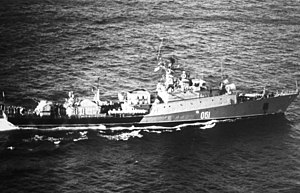Grisha-class corvette

Grisha I-class corvette
|
|
| Class overview | |
|---|---|
| Name: | Grisha class |
| Builders: | Zelenodol'sk Zavod, Kazan, Komsomolsk, Leninskaya Kuznitsa, Kiev, Zaliv Zavod 532, Kerch, Ukraine |
| Operators: | |
| Succeeded by: | Steregushchy class |
| General characteristics | |
| Type: | Anti-submarine corvette |
| Displacement: |
|
| Length: | 71.6 m (235 ft) |
| Beam: | 9.8 m (32 ft) |
| Draught: | 3.7 m (12 ft) |
| Propulsion: |
|
| Speed: | 34 knots (63 km/h; 39 mph) |
| Range: | 4,000 nautical miles (7,400 km; 4,600 mi) at 10 kn (19 km/h; 12 mph) |
| Complement: | 60 |
| Sensors and processing systems: |
|
| Electronic warfare & decoys: |
Bizan-4B suite with Watch Dog intercept |
| Armament: |
|
The Albatros class (Russian: Альбатрос; NATO reporting name: Grisha) was a series of anti-submarine corvettes built by the Soviet Union between 1970 and 1990. These ships had a limited range and were used only in coastal waters. They were equipped with a variety of ASW weapons and an SA-N-4 surface-to-air missile launcher. All were fitted with retractable fin stabilizers. Russian type designation was Malyy Protivolodochnyy Korabl (Small Anti-Submarine Ship).
Grisha V-class corvette
Grisha V-class corvette MPK-118 Suzdalets.
Grisha III-class corvette Žemaitis (Lithuanian Navy, 2003)
Grisha III-class corvette Aukštaitis (Lithuanian Navy, 2003)
...
Wikipedia
